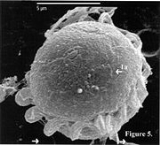
Pfiesteria shumwayae
Encyclopedia
Pseudopfiesteria shumwayae is a heterotroph
ic dinoflagellate
species in the genus Pseudopfiesteria. It was first characterized in North Carolina
in 2000. It can acquire the ability for photosynthesis
through eating green algae and retaining their chloroplast
s. It can also turn predatory and toxic strains of Pseudopfiesteria shumwayae have been implicated in fish kills around the US east coast. Pseudopfiesteria shumwayae has been described as having a less complex life cycle than Pfiesteria piscicida
.
to kill its prey has been subject to controversy. A study published in 2002 has shown that it is capable of killing fish by direct contact and feeding on their skin through micropredation
. Toxicity levels appear to depend on the strains and assays used in the laboratory. Pfiesteria shumwayae toxin present in filtered water can cause cognitive deficits in rats.
" to a high concentration. High concentrations of Pseudopfiesteria shumwayae have been found in the following locations:
Heterotroph
A heterotroph is an organism that cannot fix carbon and uses organic carbon for growth. This contrasts with autotrophs, such as plants and algae, which can use energy from sunlight or inorganic compounds to produce organic compounds such as carbohydrates, fats, and proteins from inorganic carbon...
ic dinoflagellate
Dinoflagellate
The dinoflagellates are a large group of flagellate protists. Most are marine plankton, but they are common in fresh water habitats as well. Their populations are distributed depending on temperature, salinity, or depth...
species in the genus Pseudopfiesteria. It was first characterized in North Carolina
North Carolina
North Carolina is a state located in the southeastern United States. The state borders South Carolina and Georgia to the south, Tennessee to the west and Virginia to the north. North Carolina contains 100 counties. Its capital is Raleigh, and its largest city is Charlotte...
in 2000. It can acquire the ability for photosynthesis
Photosynthesis
Photosynthesis is a chemical process that converts carbon dioxide into organic compounds, especially sugars, using the energy from sunlight. Photosynthesis occurs in plants, algae, and many species of bacteria, but not in archaea. Photosynthetic organisms are called photoautotrophs, since they can...
through eating green algae and retaining their chloroplast
Chloroplast
Chloroplasts are organelles found in plant cells and other eukaryotic organisms that conduct photosynthesis. Chloroplasts capture light energy to conserve free energy in the form of ATP and reduce NADP to NADPH through a complex set of processes called photosynthesis.Chloroplasts are green...
s. It can also turn predatory and toxic strains of Pseudopfiesteria shumwayae have been implicated in fish kills around the US east coast. Pseudopfiesteria shumwayae has been described as having a less complex life cycle than Pfiesteria piscicida
Pfiesteria piscicida
Pfiesteria piscicida is a dinoflagellate species of the genus Pfiesteria that some researchers claim is responsible for many harmful algal blooms in the 1980s and 1990s on the coast of North Carolina and Maryland...
.
Toxicity
While toxic strains of Pseudopfiesteria shumwayae have been implicated in fish kills, its ability to secrete an exotoxinExotoxin
An exotoxin is a toxin excreted by a microorganism, like bacteria, fungi, algae, and protozoa. An exotoxin can cause damage to the host by destroying cells or disrupting normal cellular metabolism. They are highly potent and can cause major damage to the host...
to kill its prey has been subject to controversy. A study published in 2002 has shown that it is capable of killing fish by direct contact and feeding on their skin through micropredation
Myzocytosis
Myzocytosis is a method of feeding found in some heterotrophic organisms...
. Toxicity levels appear to depend on the strains and assays used in the laboratory. Pfiesteria shumwayae toxin present in filtered water can cause cognitive deficits in rats.
Taxonomy
Based on 2005 research, the previously known Pfiesteria shumwayae should be reassigned its own genus based on both morphological analysis and molecular evidence as supported by rDNA analysis. Although in close resemblance to Pfiesteria piscicida, it differs in two important precingular plates 5" and 6", which historically, only one plate difference would be sufficient to place in a separate genus. Shumwayae's new genus is now Pseudopfiesteria.Occurrence
Pfiesteria has a worldwide distribution and is typically found in estuaries and coastal habitats. It is usually benign unless it "bloomsAlgal bloom
An algal bloom is a rapid increase or accumulation in the population of algae in an aquatic system. Algal blooms may occur in freshwater as well as marine environments. Typically, only one or a small number of phytoplankton species are involved, and some blooms may be recognized by discoloration...
" to a high concentration. High concentrations of Pseudopfiesteria shumwayae have been found in the following locations:
- Taskinas Creek, a tributary of the York RiverYork River (Virginia)The York River is a navigable estuary, approximately long, in eastern Virginia in the United States. It ranges in width from at its head to near its mouth on the west side of Chesapeake Bay. Its watershed drains an area including portions of 17 counties of the coastal plain of Virginia north...
in James City County, VirginiaVirginiaThe Commonwealth of Virginia , is a U.S. state on the Atlantic Coast of the Southern United States. Virginia is nicknamed the "Old Dominion" and sometimes the "Mother of Presidents" after the eight U.S. presidents born there...
, in March 2005.

